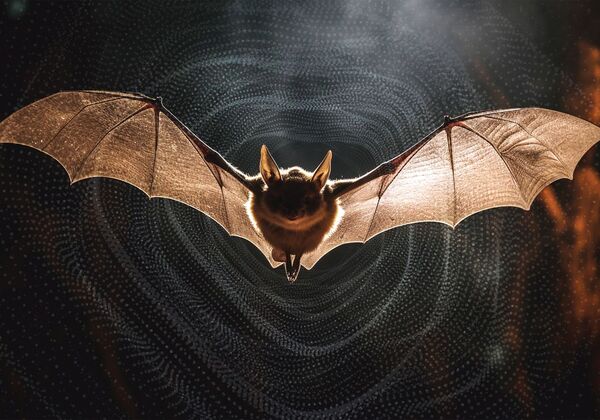The Ebola virus is one of the deadliest viruses known to humanity, and it has caused multiple outbreaks in Africa, leading to high mortality rates. The virus first appeared in 1976 near the Ebola River in what is now the Democratic Republic of Congo, giving the virus its name. One of the key questions scientists have tried to answer is: What animal carries the Ebola virus? Understanding which animals harbor the virus is crucial in preventing and controlling outbreaks.
While various animals have been implicated in the spread of Ebola, the most likely reservoir host (an animal that carries the virus without being affected by it) is believed to be fruit bats, particularly the pteropodid family of bats, also known as Old World fruit bats.

Fruit bats are widely considered to be the primary carriers of the Ebola virus, though they don’t exhibit any symptoms of the disease. They are the natural reservoir for many viruses due to their unique immune system, which allows them to harbor pathogens without suffering from the illnesses these pathogens cause in other animals. Specific species linked to Ebola include:
Hypsignathus monstrosus (Hammer-headed fruit bat)
Epomops franqueti (Franquet's epauletted fruit bat)
Myonycteris torquata (Little collared fruit bat)
These bats live in tropical rainforests in Africa, often in close proximity to humans and other animals, making the transmission of the virus possible.
While bats are considered the main reservoirs, other animals can also become infected and play a role in spreading the virus, particularly to humans.
Chimpanzees and gorillas have been found to be highly susceptible to the Ebola virus. They can contract the disease and suffer severe outbreaks, just like humans. There have been documented cases where large numbers of these primates died from Ebola infections. However, they are not considered a natural reservoir because the virus is as deadly to them as it is to humans. Rather, they can act as intermediate hosts, and humans who hunt and consume bushmeat from infected primates may contract the virus.
Duikers, a type of small African antelope, have also been found infected with Ebola during outbreaks. These animals are commonly hunted for food in parts of Africa, and handling or consuming infected duikers can transmit the virus to humans. Similar to primates, duikers are likely accidental hosts rather than natural reservoirs of the virus.
In some cases, pigs have been experimentally infected with Ebola, and they have shown the ability to spread the virus to other animals, including primates. Pigs could serve as an amplifying host, where the virus multiplies rapidly and increases the risk of transmission to other animals or humans. However, pigs are not considered a natural host of the virus in the wild.
The Ebola virus spreads through direct contact with the bodily fluids (blood, saliva, urine, feces) of an infected person or animal. The virus can enter the body through breaks in the skin or mucous membranes (eyes, nose, mouth). Additionally, contaminated surfaces and objects, such as needles, can transmit the virus.
In the context of animals, humans typically become infected through contact with or consumption of infected bushmeat, such as primates or duikers, or through handling infected bats or bat droppings. Once a human becomes infected, the virus can spread rapidly from person to person through direct contact.
Ebola is a zoonotic virus, meaning it is transmitted from animals to humans. Zoonotic diseases can be particularly challenging to control because of the interactions between humans and wildlife. Outbreaks of Ebola have often started in remote, rural areas of Africa where humans and animals live in close proximity, and hunting or farming practices increase the risk of cross-species transmission.
Bats, especially fruit bats, play a significant role in the life cycle of Ebola outbreaks. Their ability to fly long distances, live in large colonies, and interact with multiple animal species makes them an ideal reservoir for spreading the virus. Humans can become infected when they come into contact with bat feces, urine, or saliva, either directly or through contaminated fruits or surfaces.
Ebola outbreaks often start with a spillover event, where the virus jumps from an infected animal to a human. Spillover events usually occur when people handle or consume animals that are infected with the virus. Once the virus makes the leap to humans, it can spread from person to person, leading to the devastating outbreaks seen in parts of Africa.
Reducing human exposure to Ebola's natural reservoirs, particularly fruit bats, is essential in preventing future outbreaks. Here are some measures to reduce the risk of Ebola transmission:
Avoiding Bushmeat: Communities in areas prone to Ebola outbreaks should be cautious about hunting and consuming wild animals, especially primates and fruit bats. Proper cooking and handling of meat are essential if it is to be consumed.
Education and Awareness: Educating people in high-risk areas about the dangers of handling wildlife and how the virus is transmitted can help reduce spillover events.
Limiting Contact with Bats: Minimizing direct contact with bats, as well as bat habitats, can decrease the likelihood of human exposure to the virus.
Proper Hygiene: Avoiding contact with bodily fluids of infected individuals or animals, and practicing good hygiene (such as washing hands regularly), can help prevent the virus from spreading.
The Ebola virus is a deadly zoonotic pathogen, and fruit bats are widely considered to be the primary natural reservoir. Other animals, such as non-human primates and duikers, can also play a role in spreading the virus, particularly through human consumption of bushmeat. Understanding the transmission pathways and how Ebola interacts with both wildlife and humans is critical in preventing future outbreaks. Reducing human-animal contact, raising awareness, and practicing proper hygiene are key strategies in mitigating the risk of Ebola.
animal tags: Ebola
We created this article in conjunction with AI technology, then made sure it was fact-checked and edited by a Animals Top editor.